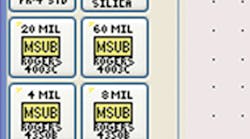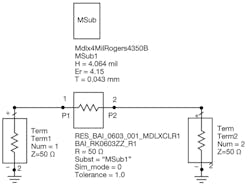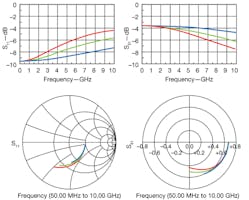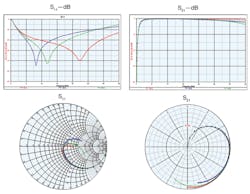This file type includes high resolution graphics and schematics.
High-frequency circuit models require a great deal of knowledge about the passive resistive-inductive-capacitive (RLC) components used in those circuits, as well as the circuit-board materials, thicknesses, and operating conditions—including temperatures. To aid RF/microwave circuit designers, Modelithics has developed Global Models™. These are software simulation models of different RLC component families that make possible rapid RF and microwave circuit design and manufacturing success by means of scalability of multiple parameters within the passive component models. Scalable input parameters include part value and specific substrate characteristics, such as circuit board thickness (H) and dielectric constant (εr) along with a number of other parameters.1. This modeling process finds success by being able to quickly evaluate a model’s performance as it is mounted on different substrate materials, and being able to perform statistical analyses using tolerances of part values for components as well as for substrate parameters.2. This approach helps to ensure a higher probability of manufacturing success based on the software models.
1. This substrate library is located in the palette’s tab of an ADS schematic.
The dielectric materials used for printed-circuit boards (PCBs) at RF and microwave frequencies are too often taken for granted as part of computer-aided-engineering (CAE) models, even though these materials consist of a blend of multiple dielectric and metal materials. Developing models for any circuit parameters—including PCB materials—requires accurate measurements to better understand how a component or material behaves under typical application circuit (e.g., microstrip) operating conditions.
2. This model employs 4-mil RO 4350B™ circuit laminate from Rogers Corp. as the substrate material.
As a byproduct of the characterization/testing performed to develop the Global Model library, a number of properties were also obtained for some of the more popular substrate materials used at RF and microwave frequencies, from leading materials suppliers. In fact, new measurement-based substrate libraries are included beginning with Version 9.0 of the Modelithics COMPLETE Library for the Advanced Design System (ADS) software suite from Agilent Technologies and Version 8.3 of the Modelithics COMPLETE Library for the Agilent Genesys software suite. The substrate library provides for improved accuracy and convenience in simulating PCB-based designs. Some examples will be presented here for using the substrate library to generate scattering (S) parameter plots for passive models in the ADS and Genesys software tools, working with different thicknesses of some leading commercial PCB materials.
3. This S-parameter schematic in ADS will simulate a model with three different substrates.
When using the ADS simulator, substrate information can be found by scrolling to the MDLX_SUBv(*.*)_Substrates choice in the pull-down menu located above the Palette tab. An available substrate is selected from this palette and placed in the schematic window. A selected PCB substrate material is assigned to a specific model by entering the substrate’s instance name into the model’s “Subst” parameter. Figures 1 and 2 provide examples of the substrate library location and substrate assignment.
4. This ADS display shows the results of simulating the schematic in Fig. 3 from DC to 10 GHz for 4-mil (red), 10-mil (blue), and 15-mil (green) circuit substrates.
Figure 3 offers an example of Modelithics resistor model RES-BAI-0603-001. In Fig. 3, it is shown simulated with three different substrates: 4- and 10-mil Rogers 4350B™ laminates and 15-mil alumina material. Figure 4 shows the S11 and S21 responses of the simulation. In this example, the red trace is 4-mil Rogers 4350B laminate, the blue trace is 10-mil Rogers 4350B laminate, and the green trace is alumina.
When using the Agilent Genesys software, the substrate to be considered as part of a circuit must be added to the Workspace from the Modelithics substrate library. For this article, three different cases were evaluated by means of software simulation: the aforementioned 4-mil-thick Rogers 4350B laminate, 10-mil-thick Rogers 4350B laminate, and 15-mil alumina. The desired substrates must be selected one at a time and added to the software’s Workspace Tree for analysis.
5. This S-parameter schematic in Genesys will simulate a model with three different substrates.
In the “Model Properties” window of the Modelithics Global Model, there is a pull-down tab that shows what substrate information is linked to this Workspace. The “Model Properties” window can be accessed by right clicking the model and selecting “Properties,” located near the bottom of the on-screen software menu. Once the model properties window is open, the substrate information can be changed by selecting a new substrate from the “SUBST” tab in the program.
Figure 5 offers an example of Modelithics capacitor model CAP-TDK-0201-201 and how is it is simulated with the three different substrate materials previously mentioned. Figure 6 provides S11 and S21 responses at frequencies through 35 GHz, allowing the three substrate materials to be compared.
6. These plots from the Genesys simulation show model responses from DC to 35 GHz for 4-mil (red), 10-mil (blue), and 15-mil (green) substrates.
The Modelithics measurement-based substrate libraries help achieve improved accuracy when simulating board level designs. Readers interested in learning more about using these substrate libraries with the Genesys simulator can download a copy of the four-page Application Note 43—available from the “Literature” section of the Modelithics website, following a short registration process—along with an associated set of example input files. Those wanting more details and an example with Agilent’s ADS simulator can download Application Note 44 (with associated files) from the Modelithics site.
Scott Muir, Student Intern
Eric O'Dell, IT Engineer
Laura Levesque, Applications Engineer
Hugo Morales, Project Lead Engineer
Larry Dunleavy, President
Modelithics, Inc., 3650 Spectrum Blvd., Ste. 170, Tampa, FL 33612; (888) 359-6539, e-mail: [email protected], www.modelithics.com.
References
1. “Comprehensive Models for RLC Components to Accelerate PCB Designs,” Microwave Journal, May, 2004.
2. Larry Dunleavy and L. van der Klooster, “Improved MW Circuit Design Flow Through Passive Modal Yield and Sensitivity Analysis, IEEE IMS2012 MicroApps Presentation, Montreal, Quebec, Canada, June, 2012.
This file type includes high resolution graphics and schematics.







